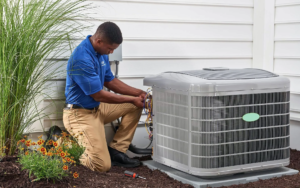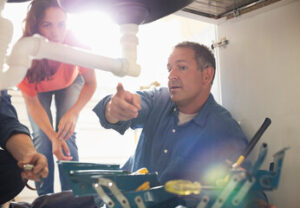Hvac Lexington KY technicians have specialized tools and knowledge to perform system repairs efficiently and offer advice on energy-saving strategies. Regular maintenance can help identify issues before they become costly.
A clean air filter helps ensure proper ventilation and improves indoor air quality. It can also reduce energy consumption by reducing the strain on your HVAC system.

A functioning heating system is a must-have for many homes and businesses. It keeps spaces warm and comfortable in the chilly winter months and helps maintain a healthy environment. It is typically a gas furnace, boiler or heat pump that provides warmth through conduction, convection and radiation. The system can be powered by electricity, propane, heating oil or natural gas.
It also entails ventilation equipment that circulates fresh air into occupied space and exhausts stale or polluted air to the outside. It also regulates temperature, humidity and air quality for optimal occupant comfort, productivity and health. The HVAC system is a vital component of residential structures such as single-family homes, apartment buildings, hotels and hospitals; commercial and industrial spaces such as office buildings and warehouses; and automobiles, aircraft, trains, ships and submarines.
HVAC technology is constantly improving to better serve occupants. Among the most significant improvements is a focus on reducing energy consumption by optimizing equipment performance. This can be accomplished by replacing older equipment with high-efficiency equipment. It also can be done by monitoring power usage patterns, looking for anomalies and identifying opportunities to save energy.
HVAC technicians can help you determine the best equipment for your needs, budget and location by taking into account factors such as a building’s size and structure, climate, and architectural design. They can also recommend energy efficiency solutions, such as duct-free systems, which provide individual control of each room. Duct-free systems have larger upfront costs than traditional systems, but they are a good choice for some structures because of their flexible installation options. They are more economical for small to medium-sized business facilities, as they can be installed in rooms without access to existing ductwork.
Cooling
Cooling is an important part of the HVAC system that helps maintain comfortable temperatures during the summer. The cooling components of your home’s air conditioner use refrigerant, compressors and coils to absorb heat from the air, which is then blown out through the fan to cool your house.
Airflow is an essential factor in how your HVAC systems performs and can be affected by many things, including dirty air filters, poor home maintenance, clogged gutters and outdoor debris. If you notice any of these problems, make sure to correct them as soon as possible so your HVAC system is operating efficiently.
Some HVAC systems have multiple settings that help you control how cool your house is and how much energy it uses. If your system is older, it might have a single-stage setting; newer systems are usually two-stage or variable speed, which uses less energy and provides more precise temperature control. You can also reduce your energy bills and extend the life of your air conditioning system by keeping it clean and replacing its filter regularly.
The temperature of the air outside and how humid it is can affect your HVAC system’s ability to cool your house. High humidity levels can cause the system to work harder to lower your home’s temperature, which increases wear and tear on the equipment. If your humidity levels are too high, consult a professional for tips and advice on how to fix the problem.
There are four types of HVAC systems: split system, hybrid systems, ductless systems and packaged heating and air systems. Each type of unit has its own pros and cons.
Thermostat
The thermostat is essentially the brain that controls your heating and cooling system. It reads the environment temperature and then tells your HVAC system when to turn on or off, based on the desired temperature you set. If the thermostat fails, the system can’t run properly.
A few common issues can cause the thermostat to fail, such as dirt or dust build-up. To prevent this, it’s best to keep the thermostat clean and free of dust and other debris. Additionally, you should regularly replace the batteries in your thermostat to prevent them from failing. You can also hire a professional to do this as part of your hvac maintenance routine.
Another common issue is a faulty heat anticipator, which can cause the HVAC system to short cycle, turning on and off too frequently to maintain the desired temperature. This can cause your home to be too warm or too cold, resulting in high energy bills.
Thermostat problems can be difficult to diagnose, but you should always start with the basics. First, make sure the thermostat isn’t plugged into a power source and that the breaker hasn’t tripped in the electrical panel. Then, you should check the battery and reset the system if it’s unresponsive. If the problem persists, you should call a professional to inspect the thermostat and its wiring connections. You can avoid these problems by regularly replacing the batteries, cleaning the sensing element, and having a professional test the wiring connections on your thermostat during your hvac maintenance. This will only take a few minutes and can save you from expensive repair bills later. Lastly, you should also place your thermostat in an average part of the house away from areas that experience extreme temperatures changes.
Combustion Chamber
A combustion chamber is the area within an internal-combustion engine where fuel is combusted, producing air and heat. It is made of a cylinder, piston bowl, valve recesses and the area of the cylinder head above the piston (top land-crevice). The cylinder must be large enough to allow the air motion to provide intensive mixing between unburned gases and oxygen for complete combustion. The shape of the combustion chamber is a major factor in the quality of combustion. The ideal chamber is spherical, which minimizes surface area and thereby reduces unburned hydrocarbon emissions.
The combustor also must be designed to reduce the generation of nitrogen oxides during combustion by minimizing the reaction between nitrogen from the air and hydrocarbons in the exhaust. This can be accomplished by maintaining reducing conditions and using methods such as two-stage combustion or product gas recirculation.
Combustion chamber deposits, which are a result of the fuel-air interaction during compression and ignition, are a well-documented cause of driveability problems and an increase in octane requirement. The deposits form an insulating layer that interferes with air flow through the intake manifold, resulting in a loss of performance and power.
The cylinder walls must be strong enough to withstand the stresses of the combustion process. The thickness of the cylinder wall and the material used are important factors. A thicker wall is generally stronger, but it will increase the cylinder pressure. The design of the cylinder lining is another important consideration. A refractory coating is a common choice for the interior of the cylinder wall, since it is durable and can withstand high temperatures. The combustion chamber throat is also an important aspect of the combustion chamber. The design of the throat is to optimize the air velocity for mixing with secondary air and recycled air in the postcombustion zone.
Heat Pump
Heat pumps are a less common HVAC system than furnaces and air conditioners, but they’re gaining popularity as an energy-efficient alternative. They can replace traditional furnaces and air conditioners, or they can provide supplemental heating and cooling for homes with existing ductwork.
Unlike gas furnaces, which rely on open flames and volatile gases, heat pumps use electrically powered coils to move warm air through your home’s supply registers. They also produce far fewer carbon emissions than fossil fuel-powered systems, making them one of the most eco-friendly types of heating and cooling equipment available.
The air source of a heat pump can be the ground, the air around your home, or both. The operation is the same in both air-source and ground-source heat pumps. A small amount of electricity is used to switch the heat pump’s process into reverse mode, causing it to pull heat from low-temperature areas and push it into high-temperature zones.
Heat pumps can help homeowners reduce their energy bills by lowering cooling costs and providing free, renewable heat in the winter.
If your heat pump is making rattling noises, it may be because of dirty evaporator and condenser coils. They must be cleaned every year to keep your heat pump operating at peak efficiency. Whether you clean them yourself or have an HVAC technician do it for you, these dirty coils will cause your unit to work harder and run longer in order to cool and heat your home.
Another potential problem is that your thermostat settings are incorrect, or the heat pump’s reversing valve may need to be replaced. If this happens, your hvac technician can help you find the right solution.
